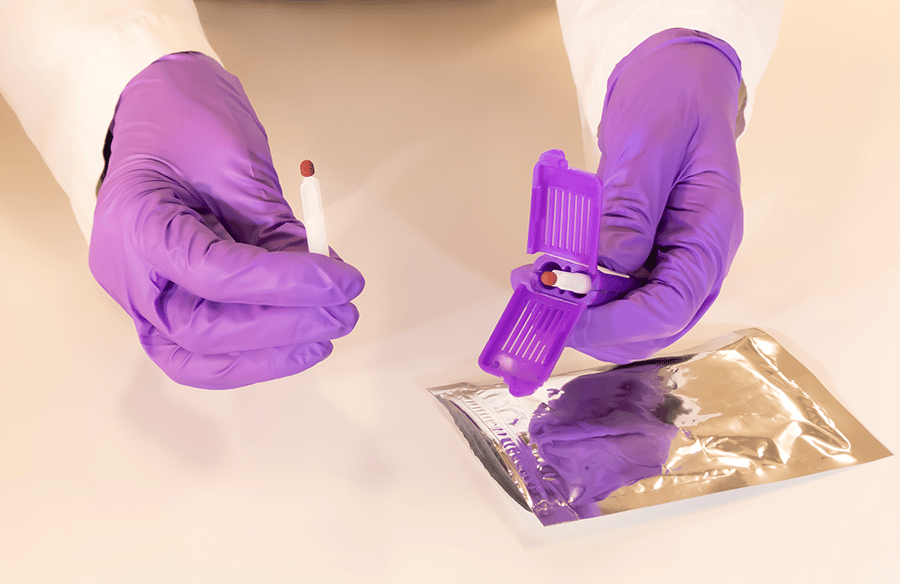Share this
4 ways blood microsampling is changing the world
by Neoteryx Microsampling on Apr 4, 2018 4:44:00 AM

Thanks to advances in science, it is now possible to generate a large amount of data from a small amount of biological fluid. If appropriately collected, samples as small as 10 or 20 μL can yield enormous amounts of information. The process of collecting these small samples of blood, urine, or other such material is called microsampling.
It seems simple, but microsampling has revolutionary implications across the fields of science, research, and healthcare. Here are a few of the ways in which microsampling is changing the world.
1) Remote Blood Sampling

With minimal training, almost anyone can use a microsampling device to collect a small blood sample, anywhere, at any time. The process doesn’t require large blood draws, venipuncture with needles, or lab equipment.
This gives patients greater agency, provides comfort to pediatric patients and those unable to visit a clinic, and opens access to remote regions where access was limited before. It makes people more independent, and brings us closer together.
In the last year alone, researchers and healthcare professionals have used microsampling technology to measure biomarkers for malnutrition in Liberia, and to lead a group of organ transplant patients on a trek up Mt. Kilimanjaro. Remote sampling literally opens the landscape for research and medicine.
2) Therapeutic Drug Monitoring

For patients who require therapeutic drug monitoring at regular and frequent intervals, the requirements of TDM can comprise their personal and professional lives. When an individual must spend enormous slices of time in clinics and waiting rooms, families and entire communities can be affected.
Microsampling allows TDM patients to participate more effectively in treatment. When they can collect their own samples at home, their lives are less disrupted. The comfort and convenience ripples out to others who depend on having these individuals available, comfortable, and happy.
Meanwhile, health care professionals have access to the accurate and reliable data they need to care for their patients, wherever they may be.
3) Clinical Trials

Clinical trials are a crucial part of evaluating new drugs and treatments. Participation in clinical trials is almost always voluntary and frequently demands heavy sacrifice of those who participate, often with no guarantee of immediate compensation.
Therefore, recruiting and retaining participants for clinical trials has always been a significant challenge for their facilitators.
Microsampling can make this process easier, for patients who can now collect blood samples at home, and for facilitators who have access to people who are now more willing and able to help.
4) Animal Research

Animal research is another essential part of the research process, albeit a controversial one. It is important to make animal research more ethical and practical, for animals and the humans who work with them.
By collecting smaller samples, laboratories can reduce the number of animals used by up to sevenfold. For the lab rodents that are needed, the experience requires less blood and causes less stress.
Researchers are always looking for new ways to work more effectively and compassionately with their animal colleagues, and microsampling has the potential to make the entire field not only more humane, but more cost-effective as well.
Trajan® has been on the cutting edge of developing Volumetric Absorptive Microsampling (VAMS™) technology. It manufactures the Mitra® microsampling device, the leading instrument for collecting small, volumetrically accurate samples, and can be used by as a sampling solutions to advance many areas of research and healthcare.

Share this
- Microsampling (206)
- Research, Remote Research (119)
- Venipuncture Alternative (105)
- Clinical Trials, Clinical Research (83)
- Mitra® Device (73)
- Therapeutic Drug Monitoring, TDM (51)
- Dried Blood Spot, DBS (39)
- Biomonitoring, Health, Wellness (30)
- Infectious Disease, Vaccines, COVID-19 (24)
- Blood Microsampling, Serology (23)
- Omics, Multi-Omics (21)
- Decentralized Clinical Trial (DCT) (20)
- Specimen Collection (18)
- Toxicology, Doping, Drug/Alcohol Monitoring, PEth (17)
- Skin Microsampling, Microbiopsy (14)
- hemaPEN® Device (13)
- Preclinical Research, Animal Studies (12)
- Pharmaceuticals, Drug Development (9)
- Harpera Device (7)
- Industry News, Microsampling News (5)
- Antibodies, MAbs (3)
- Company Press Release, Product Press Release (3)
- Environmental Toxins, Exposures (1)
- July 2025 (1)
- May 2025 (1)
- April 2025 (2)
- December 2024 (2)
- November 2024 (1)
- October 2024 (3)
- September 2024 (1)
- June 2024 (1)
- May 2024 (1)
- April 2024 (4)
- March 2024 (1)
- February 2024 (2)
- January 2024 (4)
- December 2023 (3)
- November 2023 (3)
- October 2023 (3)
- September 2023 (3)
- July 2023 (3)
- June 2023 (2)
- April 2023 (2)
- March 2023 (2)
- February 2023 (2)
- January 2023 (3)
- December 2022 (2)
- November 2022 (3)
- October 2022 (4)
- September 2022 (3)
- August 2022 (5)
- July 2022 (2)
- June 2022 (2)
- May 2022 (4)
- April 2022 (3)
- March 2022 (3)
- February 2022 (4)
- January 2022 (5)
- December 2021 (3)
- November 2021 (5)
- October 2021 (3)
- September 2021 (3)
- August 2021 (4)
- July 2021 (4)
- June 2021 (4)
- May 2021 (4)
- April 2021 (3)
- March 2021 (5)
- February 2021 (4)
- January 2021 (4)
- December 2020 (3)
- November 2020 (5)
- October 2020 (4)
- September 2020 (3)
- August 2020 (3)
- July 2020 (6)
- June 2020 (4)
- May 2020 (4)
- April 2020 (3)
- March 2020 (6)
- February 2020 (3)
- January 2020 (4)
- December 2019 (5)
- November 2019 (4)
- October 2019 (2)
- September 2019 (4)
- August 2019 (4)
- July 2019 (3)
- June 2019 (7)
- May 2019 (6)
- April 2019 (5)
- March 2019 (6)
- February 2019 (5)
- January 2019 (8)
- December 2018 (3)
- November 2018 (4)
- October 2018 (7)
- September 2018 (6)
- August 2018 (5)
- July 2018 (8)
- June 2018 (6)
- May 2018 (5)
- April 2018 (6)
- March 2018 (4)
- February 2018 (6)
- January 2018 (4)
- December 2017 (2)
- November 2017 (3)
- October 2017 (2)
- September 2017 (4)
- August 2017 (2)
- July 2017 (4)
- June 2017 (5)
- May 2017 (6)
- April 2017 (6)
- March 2017 (5)
- February 2017 (4)
- January 2017 (1)
- July 2016 (3)
- May 2016 (1)
- April 2016 (2)


No Comments Yet
Let us know what you think